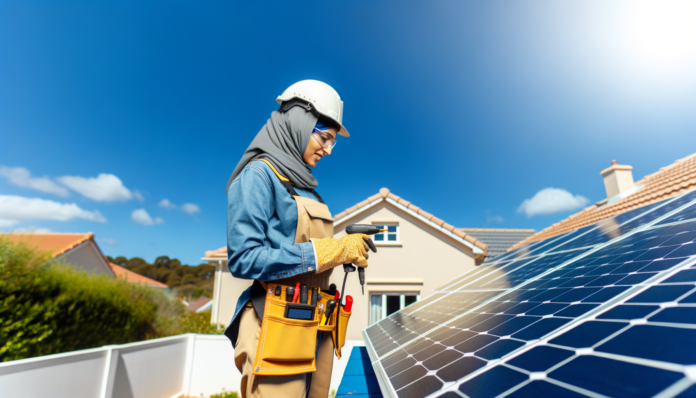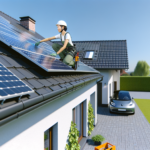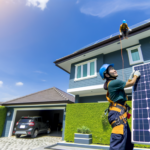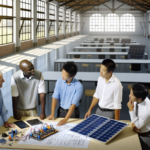Introduction
The Importance of Solar System Maintenance
Solar energy systems are a significant investment, providing clean and renewable energy for homes and businesses. To ensure that these systems perform efficiently and last for many years, periodic maintenance is crucial. Proper maintenance not only preserves system efficiency but also prevents costly repairs and prolongs the lifespan of solar panels, inverters, and other components. This guide aims to educate solar system owners on the importance of maintenance, providing practical insights, tips, and best practices for maintaining their solar energy systems.
Who This Guide is For
This guide is designed for a wide range of readers, including:
- Homeowners: Individuals who have installed or are considering installing solar panels on their homes.
- Business Owners: Those who use solar energy systems to power their commercial properties.
- DIY Enthusiasts: People who prefer to handle maintenance tasks themselves.
- Solar Technicians: Professionals looking for a comprehensive resource to share with clients.
Whether you are a novice or an experienced solar system owner, this guide will provide valuable information to help you keep your solar energy system running smoothly.
Overview of Solar System Components
Understanding the key components of a solar energy system is essential for effective maintenance. Here is an overview of the primary components:
- Solar Panels: These are the most visible part of the system, converting sunlight into electricity. They are typically mounted on rooftops or ground installations.
- Inverter: The inverter converts the direct current (DC) electricity generated by the solar panels into alternating current (AC) electricity, which can be used by household appliances.
- Batteries: Some systems include batteries to store excess energy for use during periods of low sunlight or at night.
- Wiring and Connections: These components connect the solar panels to the inverter and the inverter to the electrical grid or battery storage system.
- Mounting Hardware: This includes the brackets, rails, and other hardware used to secure the solar panels in place.
- Monitoring System: Many modern solar systems come with monitoring software that tracks energy production and system performance in real-time.
By familiarizing yourself with these components, you will be better equipped to perform routine maintenance and troubleshoot common issues. Proper care and attention to each part of the system will ensure that your solar energy system operates at peak efficiency for many years to come.
Routine Maintenance
Maintaining your solar system is crucial to ensure it operates efficiently and lasts for its full lifespan. Routine maintenance involves several key tasks, including cleaning solar panels, inspecting wiring and connections, monitoring battery health, and checking inverter performance. Below, we delve into each of these tasks in detail.
Cleaning Solar Panels
Solar panels require minimal maintenance, but keeping them clean is essential for optimal performance. Dirt, dust, and debris can accumulate on the panels, reducing their efficiency. Here are some tips for cleaning your solar panels:
- Frequency: Clean your panels at least twice a year, or more frequently if you live in an area with heavy dust, pollen, or bird droppings.
- Tools: Use a soft-bristled brush, a squeegee with a long handle, and a non-abrasive cleaner. Avoid using harsh chemicals or abrasive materials that could damage the panels.
- Safety: Clean from the ground if possible. If you need to climb onto the roof, take extreme care and consider hiring a professional.
- Timing: Clean the panels early in the morning or late in the evening when they are cool. Using cold water on hot panels can cause them to crack.
Inspecting Wiring and Connections
Regularly inspecting the wiring and connections in your solar system can prevent potential issues and ensure safety. Follow these steps:
- Visual Inspection: Look for any visible signs of wear and tear, such as frayed wires, loose connections, or corrosion.
- Check Connections: Ensure all electrical connections are tight and secure. Loose connections can lead to power loss and pose a fire hazard.
- Professional Help: If you notice any issues or are unsure about the condition of the wiring, consult a professional electrician or solar technician.
Monitoring Battery Health
If your solar system includes battery storage, monitoring the health of your batteries is vital for maintaining system performance. Here’s how to keep your batteries in good condition:
- Regular Checks: Inspect the batteries for any signs of damage, such as cracks, leaks, or swelling.
- Clean Terminals: Keep the battery terminals clean and free of corrosion. Use a mixture of baking soda and water to clean any buildup.
- Charge Levels: Monitor the charge levels regularly. Avoid deep discharges and overcharging, as these can shorten the battery’s lifespan.
- Temperature Control: Ensure the batteries are stored in a cool, dry place. Extreme temperatures can affect their performance and longevity.
Checking Inverter Performance
The inverter is a critical component of your solar system, converting the DC electricity generated by the panels into AC electricity for your home. Regularly checking the inverter’s performance can help identify issues early:
- Status Indicators: Most inverters have status indicators or display screens that show their operational status. Check these regularly for any error messages or warnings.
- Performance Monitoring: Use a monitoring system or app to track the inverter’s performance. Look for any significant drops in efficiency or output.
- Professional Inspection: Schedule an annual inspection with a solar technician to ensure the inverter is functioning correctly and efficiently.
By following these routine maintenance steps, you can keep your solar system running smoothly and efficiently, ensuring you get the most out of your investment in renewable energy.
Seasonal and Annual Checks
Preparing for Winter
Winter can pose unique challenges for solar panel systems, particularly in regions that experience heavy snowfall and freezing temperatures. To ensure your system continues to operate efficiently throughout the colder months, consider the following steps:
- Snow Removal: Accumulated snow can block sunlight and significantly reduce energy production. Use a soft brush or a roof rake with a plastic blade to gently remove snow from the panels. Avoid using metal tools that could scratch or damage the surface.
- Inspect for Ice Buildup: Ice can form on the edges of panels and wiring, potentially causing damage. Regularly check for ice and carefully remove it if necessary.
- Check Wiring and Connections: Cold weather can cause materials to contract, potentially loosening connections. Inspect all wiring and connections to ensure they are secure and free from damage.
- Monitor Performance: Use your system’s monitoring tools to keep an eye on energy production. Any significant drop in output could indicate an issue that needs addressing.
Spring System Check-Up
Spring is an ideal time to perform a thorough check-up of your solar system after the harsh winter months. This ensures that your system is ready to maximize energy production during the sunnier seasons. Here are some key tasks to include in your spring maintenance routine:
- Clean the Panels: Winter can leave behind dirt, debris, and pollen on your panels. Clean them using a soft brush and soapy water to ensure they are free from obstructions.
- Inspect for Damage: Check for any cracks, chips, or other damage that may have occurred during the winter. Pay special attention to the mounting hardware and ensure all components are secure.
- Check Inverter and Battery Health: Inspect the inverter for any error messages or unusual noises. Also, check the health of your batteries if your system includes energy storage.
- Trim Nearby Vegetation: Spring growth can lead to shading issues. Trim any trees or bushes that may cast shadows on your panels.
Annual Professional Inspection
While regular DIY maintenance is crucial, an annual professional inspection can provide a more comprehensive assessment of your solar system’s health. A certified technician can identify and address issues that may not be apparent to the untrained eye. Here’s what to expect from a professional inspection:
- Detailed System Check: The technician will perform a thorough inspection of all system components, including panels, inverters, wiring, and mounting hardware.
- Performance Analysis: They will analyze your system’s performance data to identify any inefficiencies or drops in energy production.
- Electrical System Check: A detailed check of the electrical system ensures that all connections are secure and that there are no potential safety hazards.
- Maintenance Recommendations: Based on their findings, the technician will provide recommendations for any necessary repairs or maintenance tasks to keep your system running smoothly.
By adhering to these seasonal and annual maintenance routines, you can ensure that your solar system remains efficient and reliable throughout the year. Regular checks and professional inspections not only help in maintaining optimal performance but also extend the lifespan of your solar investment.
Troubleshooting Common Issues
Low Power Output
Experiencing low power output from your solar system can be frustrating, but it is a common issue that can often be resolved with a few troubleshooting steps.
1. **Check for Shading and Dirt**: Ensure that your solar panels are not shaded by trees, buildings, or other obstructions. Clean the panels to remove any dirt, dust, or debris that may be blocking sunlight.
2. **Inspect the Inverter**: Look at the inverter display for any error messages or warnings. The inverter is crucial for converting DC electricity from the panels into AC electricity for your home.
3. **Examine Wiring and Connections**: Loose or damaged wiring can lead to power losses. Inspect all connections and tighten or replace any that are faulty.
4. **Monitor System Performance**: Use your system’s monitoring tools to check for any irregularities in power output. Compare current performance data with historical data to identify any significant drops.
Battery Not Charging
If your solar battery is not charging, it can disrupt your energy storage and usage plans. Here are some steps to diagnose and fix the issue:
1. **Check Battery Health**: Use the monitoring system to check the battery’s state of health and charge cycles. Batteries degrade over time and may need replacement.
2. **Inspect Connections**: Ensure that all connections to the battery are secure and free from corrosion. Loose or corroded connections can prevent proper charging.
3. **Examine the Charge Controller**: The charge controller regulates the flow of electricity to the battery. Check for any error codes or malfunctions.
4. **Review System Logs**: Look at the system logs for any error messages or trends that could indicate a problem with the battery or charging system.
Inverter Malfunctions
Inverters are essential for converting the DC power generated by your solar panels into AC power for your home. If your inverter is malfunctioning, follow these steps:
1. **Check for Error Codes**: Most inverters have a display that shows error codes. Refer to the manufacturer’s manual to interpret these codes and take appropriate action.
2. **Inspect for Physical Damage**: Look for any signs of physical damage, such as burnt components or loose wires. Replace any damaged parts.
3. **Restart the Inverter**: Sometimes, a simple restart can resolve minor issues. Turn off the inverter, wait a few minutes, and then turn it back on.
4. **Consult a Professional**: If the problem persists, it may be time to call a qualified technician to diagnose and repair the inverter.
Panel Damage or Degradation
Solar panels are generally durable, but they can suffer from damage or degradation over time. Here’s how to address these issues:
1. **Visual Inspection**: Regularly inspect your panels for any visible signs of damage, such as cracks, discoloration, or warping.
2. **Check for Microcracks**: Microcracks can develop in the solar cells and may not be immediately visible. These can grow over time and affect performance.
3. **Test Electrical Output**: Use a multimeter to test the voltage and current output of each panel. Compare these readings to the manufacturer’s specifications.
4. **Clean the Panels**: Dirt, pollen, and bird droppings can reduce the efficiency of your panels. Clean them regularly to maintain optimal performance.
5. **Replace Damaged Panels**: If a panel is significantly damaged or degraded, it may need to be replaced to restore the system’s efficiency.
By following these troubleshooting steps, you can address common issues with your solar system and ensure it continues to operate efficiently. Regular maintenance and timely repairs are key to maximizing the lifespan and performance of your solar investment.
Advanced Troubleshooting
Using Diagnostic Tools
Advanced troubleshooting of your solar system often begins with the use of diagnostic tools. These tools can help you identify and isolate issues more efficiently. **Multimeters** are essential for checking voltage, current, and resistance in your system’s electrical components. **Thermal cameras** can detect hotspots on solar panels, indicating potential issues like micro-cracks or shading problems. **Data loggers** and **monitoring software** provide real-time data on system performance, helping you spot anomalies quickly.
For those with a solar inverter that includes a display, you can cycle through different information screens to check parameters like grid voltage, which should not exceed 255V. If it does, your inverter may reduce power output or shut down entirely. In such cases, you might need to contact your local grid operator to address high grid voltage issues.
Interpreting Error Codes
Modern solar inverters and monitoring systems often come with error codes that can help diagnose issues. Understanding these codes is crucial for effective troubleshooting. Here are some common error codes and their meanings:
– **Error Code 101**: Indicates a grid fault. This could be due to high or low grid voltage or frequency issues.
– **Error Code 202**: Suggests a problem with the inverter’s internal components, such as overheating or a hardware malfunction.
– **Error Code 303**: Points to a communication error between the inverter and the monitoring system.
When you encounter an error code, refer to your inverter’s user manual for specific troubleshooting steps. Some issues may be resolved by resetting the inverter, while others might require professional intervention.
When to Call a Professional
While many troubleshooting tasks can be handled by a knowledgeable homeowner, certain situations warrant professional help. Here are some scenarios where calling a professional is advisable:
– **Persistent Issues**: If you’ve tried basic troubleshooting steps and the problem persists, it’s time to call in an expert. Persistent issues could indicate deeper, more complex problems that require specialized knowledge and tools.
– **Significant Power Drop**: A noticeable drop in your system’s power output, despite clean panels and optimal conditions, may signal a serious issue like inverter failure or significant panel degradation.
– **Safety Concerns**: Tasks that involve working at heights, handling high voltage, or dealing with complex electrical systems should always be performed by a licensed professional to ensure safety.
In summary, advanced troubleshooting involves a combination of using diagnostic tools, interpreting error codes, and knowing when to call a professional. By following these guidelines, you can ensure your solar system operates efficiently and safely.
Upgrading and Expanding Your System
Assessing Your Current System
Before diving into upgrades, it’s crucial to evaluate your existing solar system. Start by examining your current power output and comparing it to your energy consumption. If your energy needs have increased due to new appliances, electric vehicles, or additional household members, your current system might not be sufficient. Utilize your solar monitoring app or utility bills to track your system’s performance. Look for discrepancies between expected and actual output, which could indicate underperformance.
Additionally, inspect the physical condition of your system. Check for any signs of wear and tear, such as damaged panels or faulty wiring. Ensure that your inverter is functioning correctly, as it plays a pivotal role in converting solar energy into usable electricity. If your system is more than 20 years old, it might be more cost-effective to consider a complete overhaul rather than incremental upgrades.
Adding More Panels
If your roof has the capacity and your inverter can handle additional input, adding more panels is a straightforward way to boost your system’s output. However, it’s essential to ensure that the new panels are compatible with your existing setup. Mixing different brands or models can lead to inefficiencies, although this can be mitigated with the use of optimizers or micro-inverters.
When planning to add more panels, consider the orientation and tilt to maximize sunlight exposure. Also, check local regulations and your network provider’s policies to ensure compliance. Some jurisdictions have size limits on solar systems, and exceeding these could result in additional fees or the need for a separate installation.
Upgrading Batteries
Battery storage is a critical component for those looking to maximize their solar energy usage, especially during non-sunny periods. If your current batteries are not holding charge as efficiently as they used to, or if you find yourself frequently drawing power from the grid, it might be time for an upgrade.
Modern batteries offer higher storage capacities and improved efficiency. Lithium-ion batteries, for example, are more durable and have a longer lifespan compared to older lead-acid batteries. When upgrading, ensure that the new batteries are compatible with your existing inverter and other system components. It’s also wise to consult with a professional to determine the optimal battery size and type for your specific needs.
Integrating New Technologies
The solar industry is continually evolving, with new technologies emerging that can enhance the efficiency and functionality of your system. One such advancement is the use of smart inverters, which offer better energy management and can communicate with the grid to optimize energy usage.
Another exciting development is the integration of solar energy with smart home systems. This allows for automated energy management, where your system can adjust based on real-time data, such as weather forecasts and energy prices. Additionally, consider incorporating energy-efficient appliances and smart thermostats to further reduce your overall energy consumption.
Lastly, keep an eye on emerging technologies like solar tiles and transparent solar panels, which can offer aesthetic and functional benefits. While these might be more expensive initially, they can provide long-term savings and increased property value.
By carefully assessing your current system, adding more panels, upgrading batteries, and integrating new technologies, you can significantly enhance the performance and efficiency of your solar energy system. Regular upgrades and expansions not only meet your growing energy needs but also ensure that you are leveraging the latest advancements in solar technology.
Conclusion
Recap of Key Points
Maintaining your solar system is crucial for ensuring its longevity and optimal performance. Throughout this guide, we have covered various aspects of solar system maintenance and troubleshooting. We began by discussing the importance of regular maintenance and provided an overview of the key components of a solar system. We then delved into routine maintenance tasks such as cleaning solar panels, inspecting wiring and connections, monitoring battery health, and checking inverter performance. Seasonal and annual checks were also highlighted, including preparing for winter, conducting a spring system check-up, and scheduling an annual professional inspection. Additionally, we addressed common issues like low power output, battery not charging, inverter malfunctions, and panel damage or degradation, along with advanced troubleshooting techniques. Finally, we explored options for upgrading and expanding your solar system.
Encouragement for Regular Maintenance
Regular maintenance is not just a recommendation; it is a necessity for the efficient operation of your solar system. By staying proactive with routine checks and timely interventions, you can prevent minor issues from escalating into major problems. This not only ensures that your system operates at peak efficiency but also extends its lifespan, providing you with a higher return on your investment. Remember, a well-maintained solar system is a reliable source of clean energy that can significantly reduce your electricity bills and carbon footprint. Make it a habit to follow the maintenance guidelines outlined in this guide, and don’t hesitate to seek professional help when needed.
Resources for Further Learning
To further enhance your knowledge and skills in solar system maintenance and troubleshooting, consider exploring the following resources:
- Online Courses: Websites like Coursera, Udemy, and edX offer courses on solar energy systems, covering both basic and advanced topics.
- Manufacturer Manuals: Always refer to the manuals provided by your solar system manufacturer for specific maintenance guidelines and troubleshooting tips.
- Professional Organizations: Organizations such as the Solar Energy Industries Association (SEIA) and the International Solar Energy Society (ISES) provide valuable resources, including webinars, articles, and industry updates.
- Local Workshops: Check for local workshops or seminars on solar energy systems. These can provide hands-on experience and direct interaction with experts.
- Community Forums: Online forums and communities, such as those on Reddit or specialized solar energy websites, can be great places to ask questions and share experiences with other solar system owners.
By leveraging these resources, you can stay informed about the latest advancements in solar technology and best practices for maintenance and troubleshooting. Your commitment to regular maintenance and continuous learning will ensure that your solar system remains a reliable and efficient source of renewable energy for years to come.






